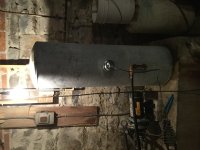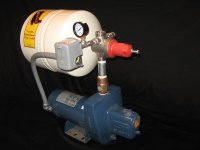CobyRupert
Super Member
Went to my moms house today. She has a (deep well) jet pump system set up with what I am guessing is a 30-40 gallon ballast tank?
The pump is short cycling.
The ballast tank is bladder-less, what I guess is called "air over water". It uses a (Campbell) Brady AV30 (maybe AV-100?) "air volume control" valve on the side of the tank that has a vacuum line that is connected to the jet pump.
When I got there, pump would turn on at about 32psi and off at 60psi (then immediately snap back to about 55psi) and hold. But if I opened a faucet the pressure would quickly drop to 32psi and the pump would turned back on.
So I replaced the air volume control valve, like I do every 5 years, it was due; and blew out the vacuum line that connects the opposite side of the valve to the jet pump.
...but now I only get 1-2 gallons before pump drops from 55psi to 32psi !!??
So I adjust pressure switch so range is 60 psi (off) to 20 psi (on) and I only get 2-4 gallons from a 30 (40?) gallon tank??!
This can't be normal? Why is it still short cycling?l
1) Did I not drain the tank enough (or too much) when I switched the air volume control valve? What should the proper level have been?
2) How do the air volume control valves work?
- I assume the "valve" portion of it opens so air is sucked into the jet pump and sent to the ballast tank?
- I assume the diaphragm portion detects that the vacuum pressure of the pump is lower than the tank side and uses this differential to opens the air valve?
Is this right? Is there an install "this side up" / float to them (i.e. do they know if the pressure in the tank is from air or water
The pump is short cycling.
The ballast tank is bladder-less, what I guess is called "air over water". It uses a (Campbell) Brady AV30 (maybe AV-100?) "air volume control" valve on the side of the tank that has a vacuum line that is connected to the jet pump.
When I got there, pump would turn on at about 32psi and off at 60psi (then immediately snap back to about 55psi) and hold. But if I opened a faucet the pressure would quickly drop to 32psi and the pump would turned back on.
So I replaced the air volume control valve, like I do every 5 years, it was due; and blew out the vacuum line that connects the opposite side of the valve to the jet pump.
...but now I only get 1-2 gallons before pump drops from 55psi to 32psi !!??
So I adjust pressure switch so range is 60 psi (off) to 20 psi (on) and I only get 2-4 gallons from a 30 (40?) gallon tank??!
This can't be normal? Why is it still short cycling?l
1) Did I not drain the tank enough (or too much) when I switched the air volume control valve? What should the proper level have been?
2) How do the air volume control valves work?
- I assume the "valve" portion of it opens so air is sucked into the jet pump and sent to the ballast tank?
- I assume the diaphragm portion detects that the vacuum pressure of the pump is lower than the tank side and uses this differential to opens the air valve?
Is this right? Is there an install "this side up" / float to them (i.e. do they know if the pressure in the tank is from air or water
Attachments
Last edited:

